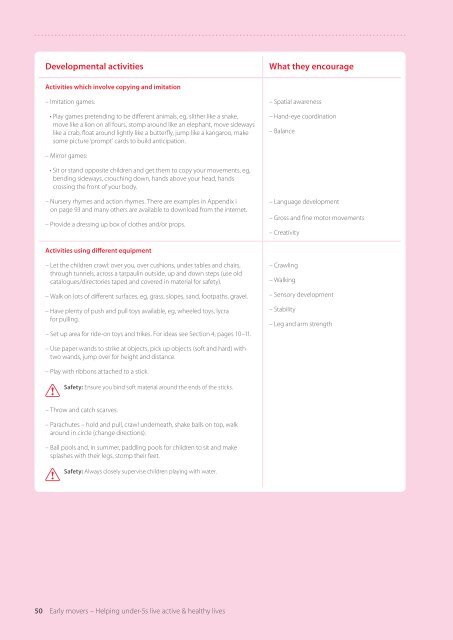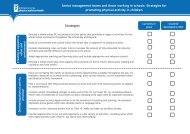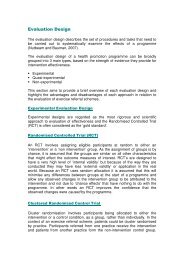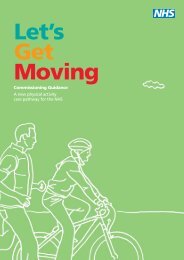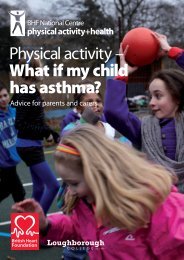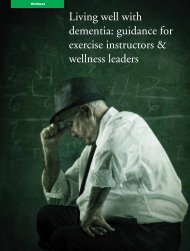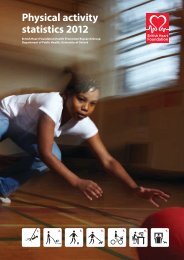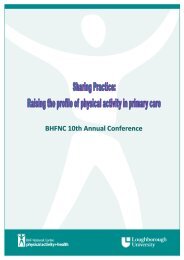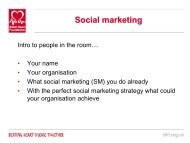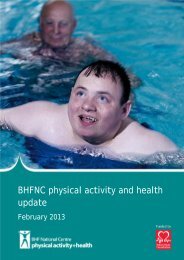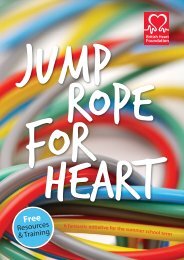5 Practical ideas for physically active play - BHF National Centre ...
5 Practical ideas for physically active play - BHF National Centre ...
5 Practical ideas for physically active play - BHF National Centre ...
- No tags were found...
Create successful ePaper yourself
Turn your PDF publications into a flip-book with our unique Google optimized e-Paper software.
Developmental activitiesWhat they encourageDevelopmental activitiesWhat they encourageActivities which involve copying and imitationActivities using balls (of various sizes and textures)– Imitation games:• Play games pretending to be different animals, eg, slither like a snake,move like a lion on all fours, stomp around like an elephant, move sidewayslike a crab, float around lightly like a butterfly, jump like a kangaroo, makesome picture ‘prompt’ cards to build anticipation.– Spatial awareness– Hand-eye coordination– Balance– Roll a large ball close to a child and encourage them to bend and pick upand throw it back.– Aiming at targets (on floor, wall, bucket or objects).– Kicking.– Mirror games:– Throwing:• Sit or stand opposite children and get them to copy your movements, eg,bending sideways, crouching down, hands above your head, handscrossing the front of your body.• at objects and <strong>for</strong> distance• towards a person to catch– Hand-eye coordination, balance andstrengthen muscles– Nursery rhymes and action rhymes. There are examples in Appendix ion page 93 and many others are available to download from the internet.– Provide a dressing up box of clothes and/or props.Activities using different equipment– Let the children crawl: over you, over cushions, under tables and chairs,through tunnels, across a tarpaulin outside, up and down steps (use oldcatalogues/directories taped and covered in material <strong>for</strong> safety).– Language development– Gross and fine motor movements– Creativity– Crawling– Walking• in the air and catching it themselves (beach ball or other large ball).– Catching (on their own or with a partner).– With a partner – use a large, soft ball, eg, beach ball or foam ball, standfacing the child with a small gap, ask them to make a basket with their arms,and gently throw the ball into their arms.– Striking – hang balls at different heights. Use hands or cardboard wand/smallbat to strike them with. Position balls:• high to strike at– Walk on lots of different surfaces, eg, grass, slopes, sand, footpaths, gravel.– Sensory development• medium to hit at waist height– Have plenty of push and pull toys available, eg, wheeled toys, lycra<strong>for</strong> pulling.– Set up area <strong>for</strong> ride-on toys and trikes. For <strong>ideas</strong> see Section 4, pages 10–11.– Use paper wands to strike at objects, pick up objects (soft and hard) withtwo wands, jump over <strong>for</strong> height and distance.– Stability– Leg and arm strength• low <strong>for</strong> kicking balls or striking, eg, hitting a balloon and movingit along the ground.For skills cards with prompts on throwing and catching activities,see pages 85–86.– Play with ribbons attached to a stick.Safety: Ensure you bind soft material around the ends of the sticks.– Throw and catch scarves.– Parachutes – hold and pull, crawl underneath, shake balls on top, walkaround in circle (change directions).– Ball pools and, in summer, paddling pools <strong>for</strong> children to sit and makesplashes with their legs, stomp their feet.Safety: Always closely supervise children <strong>play</strong>ing with water.50 Early movers – Helping under-5s live <strong>active</strong> & healthy livesSection 5 – <strong>Practical</strong> <strong>ideas</strong> <strong>for</strong> <strong>physically</strong> <strong>active</strong> <strong>play</strong> 51


